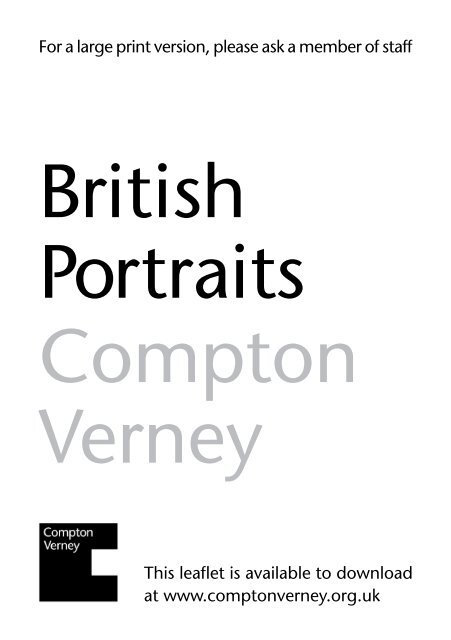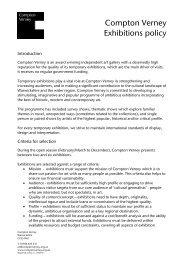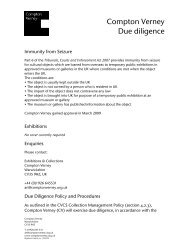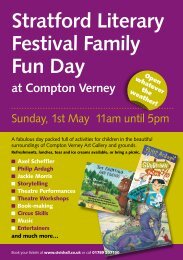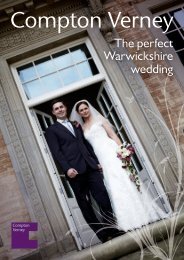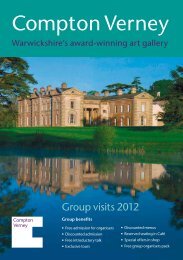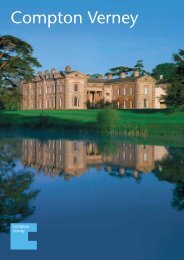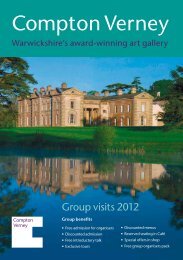Read the gallery guide - Compton Verney
Read the gallery guide - Compton Verney
Read the gallery guide - Compton Verney
You also want an ePaper? Increase the reach of your titles
YUMPU automatically turns print PDFs into web optimized ePapers that Google loves.
For a large print version, please ask a member of staff<br />
British<br />
Portraits<br />
<strong>Compton</strong><br />
<strong>Verney</strong><br />
This leaflet is available to download<br />
at www.comptonverney.org.uk
1. Marcus Gheeraerts <strong>the</strong> Younger<br />
(1561/2-1636), Flemish: A Boy Aged Two.<br />
Oil on panel, inscribed and dated<br />
Aetatis suae 2 / Anº 1608. 114.3 x 85.7 cm<br />
The child in this portrait wears a bodice and<br />
skirt over a farthingale frame. This was <strong>the</strong><br />
fashion for dressing boys until <strong>the</strong>y were<br />
‘breeched’ (dressed in breeches or trousers) at<br />
<strong>the</strong> age of five or six. In his left hand he holds a bunch of flowers<br />
and a string attached to a robin. The flowers are pansies and<br />
signified innocence and transience, whilst birds are thought to<br />
symbolise <strong>the</strong> human soul flying away at <strong>the</strong> moment of death.<br />
2. Jacopo da Trezzo<br />
(about 1514-89), Italian: Queen Mary<br />
Tudor. Silver, 1554. Diam: 6.8 cm<br />
After Jacopo da Trezzo: King Philip II<br />
of Spain, Silver electrotype, 1800s.<br />
Diam: 6.8 cm<br />
Jacopo da Trezzo was a Milanese<br />
goldsmith who specialised in<br />
elaborately-worked, cast medals, and<br />
worked for King Philip II of Spain. Queen Mary I of England<br />
reigned from 1553 until 1558, and she and Philip were married<br />
in 1554. The reverse of <strong>the</strong> Mary I medal suggests that England<br />
is a peaceful country under her rule, showing <strong>the</strong> figure of Peace<br />
burning armour and banishing storm clouds. This medal is listed<br />
in <strong>the</strong> inventory of <strong>the</strong> Chigi family of Rome, dated 22 March 1674.
3. Attributed to Daniel Marot, English:<br />
Table. Wood and marble, about 1690.<br />
H: 80 cm<br />
This unusual table is believed to have<br />
been designed by <strong>the</strong> French-born<br />
Huguenot architect and designer, Daniel Marot. It was probably<br />
commissioned by Queen Mary II for <strong>the</strong> Water Gallery at<br />
Hampton Court Palace and made by <strong>the</strong> royal cabinetmaker,<br />
William Farnborough. It served as a film prop in <strong>the</strong> studio of<br />
<strong>the</strong> great Hollywood film director Cecil B. DeMille in <strong>the</strong> 1930s<br />
and was recently restored to its original white, gold and blue<br />
decorative scheme.<br />
4. Attributed to Marcus Gheeraerts <strong>the</strong><br />
Younger (1561/2-1636), Flemish: Frances<br />
Howard, Duchess of Richmond and Lennox<br />
(1578-1639). Oil on panel, about 1621.<br />
57.5 x 44.5 cm<br />
Frances Howard’s third husband, <strong>the</strong> Duke<br />
of Lennox, was created <strong>the</strong> first Duke of<br />
Richmond and Lennox in 1623, earning her<br />
<strong>the</strong> nickname of ‘Double Duchess’. She is portrayed wearing<br />
an eye-catching, low-cut bodice embroidered in silk and gold<br />
threads, and a pendant ornament of a heart and half-moon<br />
associated with <strong>the</strong> Lennox family.<br />
5. Master of <strong>the</strong> Countess of Warwick<br />
(active about 1565), English: Sir Thomas<br />
Knyvet. Oil on panel, about 1565.<br />
99.1 x 71.7 cm<br />
Sir Thomas Knyvet (about 1539-1617) was<br />
a member of an important East Anglian<br />
landowning family who lived at Ashwellthorpe,<br />
Norfolk. He was knighted by Queen Elizabeth I<br />
during her Royal Progress in Norfolk in 1578, and became High<br />
Sheriff of Norfolk <strong>the</strong> following year. He is shown wearing a white<br />
slashed doublet and double ruffs edged with gold, and carries an<br />
elaborate sword with a green and gold sash.<br />
6. English School: Queen Elizabeth I.<br />
Oil on panel, about 1590. 114 x 88 cm<br />
In this portrait, painted late in her reign,<br />
Elizabeth is presented as an ageless symbol<br />
of <strong>the</strong> nation, immersed in jewels and rich<br />
costume. Tudor portraiture, in contrast to<br />
<strong>the</strong> painting of <strong>the</strong> Italian Renaissance, rarely<br />
employed realism and perspective as many<br />
Protestants were concerned that such images mimicked God’s<br />
work and were <strong>the</strong> cause of idolatry. Instead, artists relied on<br />
a rich tapestry of signs and symbols which were designed to<br />
be ‘read’ by <strong>the</strong> viewer. Here, Elizabeth wears an open-worked<br />
crown representing her sovereignty, and beneath it is <strong>the</strong> great<br />
central diamond known as <strong>the</strong> ‘Mirror of Portugal’. On her<br />
bodice is a jewel in <strong>the</strong> form of a moon, evoking Diana, goddess<br />
of <strong>the</strong> hunt and of chastity.
7. Follower of Hans Holbein <strong>the</strong> Younger<br />
(about 1497-1543), German: Edward, Prince<br />
of Wales, later King Edward VI. Oil on panel,<br />
about 1542. 53 x 41.5 cm<br />
Prince Edward, <strong>the</strong> only son of Henry VIII<br />
and his third wife Jane Seymour, was born at<br />
Hampton Court Palace, London, in October 1537.<br />
His mo<strong>the</strong>r died within twelve days of his birth and he was given a<br />
separate household from <strong>the</strong> age of two. This portrait was painted<br />
when he was five and depicts him as a small but powerful figure,<br />
wearing a red doublet with gold thread and a black fea<strong>the</strong>red cap.<br />
8. Attributed to William Scrots (active<br />
1537-53), Flemish: King Edward VI.<br />
Oil on panel, about 1550. 58 x 68 cm<br />
Edward VI became King in 1547 at <strong>the</strong> age<br />
of ten and ruled for six years until his death<br />
in 1553. This important profile portrait<br />
includes both <strong>the</strong> red and white rose,<br />
emblems of <strong>the</strong> Houses of Lancaster and York respectively, which<br />
were <strong>the</strong> two dynasties united by Edward’s grandfa<strong>the</strong>r, Henry<br />
VII (1457-1509) in 1485. Edward is shown with a group of plants<br />
that, instead of turning toward <strong>the</strong> sun, face <strong>the</strong> young King. Rich<br />
in symbolism, <strong>the</strong>y include (from left to right) calendula officinalis<br />
(Pot Marigold), known as <strong>the</strong> herb of <strong>the</strong> sun; dianthus caryophyllus<br />
(Clove Pink), associated with <strong>the</strong> Roman god Jupiter; viola tricolor<br />
(Heartsease), a symbol of thought and remembrance; and tall blue<br />
wild chicory, a plant that only flowers in sunlight. The inscription<br />
beneath, in both Italian and Latin, reiterates <strong>the</strong> power of <strong>the</strong><br />
King as mightier than <strong>the</strong> sun and establishes him as a ‘second<br />
Jupiter’ – a worthy successor to his fa<strong>the</strong>r, Henry VIII.<br />
9. After Hans Holbein <strong>the</strong> Younger<br />
(about 1497-1543), German: King Henry VIII.<br />
Oil on panel, about 1560. 98.2 x 72.5 cm<br />
This portrait is a version of <strong>the</strong> last official<br />
portrait painted of Henry VIII (reigned<br />
1509-47). The King employed court painters<br />
to fulfil <strong>the</strong> many demands for his likeness and<br />
used <strong>the</strong>se images as a propaganda tool to<br />
inspire loyalty and devotion in his subjects. Holbein’s original<br />
painting was copied many times, and <strong>the</strong> demand for images of<br />
Henry VIII lasted well beyond his reign. This version dates from<br />
<strong>the</strong> reign of Queen Elizabeth I (reigned 1558-1603) and would<br />
have been designed to assert <strong>the</strong> legitimacy of <strong>the</strong> Protestant<br />
succession.<br />
10. Sir William Beechey R.A. (1753-1839)<br />
British: Mirza Abu’l Hassan Khan. Oil on<br />
canvas, 1809-10. 144.2 x 137.8 cm<br />
Mirza Abu’l Hassan Khan was sent to <strong>the</strong><br />
court of King George III in 1809 by <strong>the</strong><br />
Shah of Persia, to help negotiate a treaty of<br />
alliance between Great Britain and Persia<br />
(Iran). He became a figure of fascination,<br />
and many parties were held in his honour. By this time Beechey<br />
was known as one of <strong>the</strong> foremost portrait painters of his day<br />
and painted two recorded portraits of this sitter. In his diplomatic<br />
diary Abu’l Hassan describes visiting Beechey’s house in Harley<br />
Street and his joy at meeting <strong>the</strong> artist’s children. On arrival back<br />
in Persia in 1811, he was given <strong>the</strong> honorary title of Khan, in<br />
recognition of <strong>the</strong> role he had played in <strong>the</strong> treaty negotiations.
11. Sir Joshua Reynolds (1723-92),<br />
English: Mrs Baldwin in Eastern Dress.<br />
Oil on canvas, 1782. 141 x 110 cm<br />
Mrs Jane Baldwin (1763-1839) was <strong>the</strong><br />
daughter of William Maltass, a merchant<br />
who traded with <strong>the</strong> East through <strong>the</strong><br />
Levant company. She was born in Smyrna,<br />
Turkey in June 1763 and married George<br />
Baldwin who became British Consul-<br />
General in Egypt. She was a celebrated beauty and Sir Joshua<br />
Reynolds paints her in a Persian-derived costume, consistent with<br />
<strong>the</strong> fashion for depicting sitters in fancy dress. Mrs Baldwin wore<br />
this costume on several occasions, including a ball in London<br />
given by <strong>the</strong> King, and was known as <strong>the</strong> ‘pretty Greek’.<br />
12. Samuel Cooper (1608-1672), English:<br />
Oliver Cromwell. Watercolour on vellum, signed<br />
and dated SC/1657. H: 10.4 cm<br />
Oliver Cromwell (1599-1658) was one of <strong>the</strong><br />
most controversial figures in British history. A<br />
radical puritan, he established a professional army<br />
known as <strong>the</strong> ‘New Model Army’. When civil war<br />
broke out between King Charles I and Parliament in 1642, Cromwell<br />
was instrumental in bringing Charles I to trial and execution, and<br />
making England a republic. Samuel Cooper was one of <strong>the</strong> most<br />
important and influential miniaturists of his day. Painted in 1657,<br />
this uncompromisingly honest portrait of Cromwell, wearing simple<br />
armour, has been referred to as ‘one of <strong>the</strong> most penetrating studies<br />
of a public figure ever produced’. It is believed that Cromwell’s<br />
comment urging <strong>the</strong> artist to paint him ‘pimples, warts and<br />
everything as you see me’ related to this portrait.<br />
13. Lemuel Francis Abbott (1760-1802):<br />
Horatio, Admiral Nelson, KB.<br />
Oil on canvas,1797. 76.2 x 63.5 cm<br />
Painted shortly after Nelson lost his arm in a<br />
battle at Santa Cruz, Tenerife, this portrait was<br />
commissioned by his Captain, William Locker<br />
while Nelson was convalescing at Locker’s<br />
home in Greenwich.<br />
14. Jean-Étienne Liotard (1702-89),<br />
Swiss: Lady Fawkener. Pastel on vellum,<br />
about 1760. 73.6 x 58.8 cm<br />
The sitter is Harriet Churchill, <strong>the</strong> wife of Sir<br />
Everard Fawkener, English ambassador to<br />
Constantinople (now Istanbul) from 1737 to 1746. Fawkener and<br />
<strong>the</strong> Swiss pastel painter had become acquainted in <strong>the</strong> Turkish<br />
capital, where <strong>the</strong> artist produced portraits for members of <strong>the</strong><br />
British colony. In <strong>the</strong> mid-1750s <strong>the</strong> two met again in London,<br />
where this delicate portrait is thought to have been produced.<br />
15. After a bust by Gianlorenzo Bernini, English:<br />
King Charles I. Lead, about 1675. H: 66 cm<br />
This important piece is one of only three versions<br />
known to be in existence, taken from a marble bust<br />
by Gianlorenzo Bernini which was destroyed in <strong>the</strong><br />
Whitehall Palace fire of 1698. Although <strong>the</strong><br />
sculptor of this bust is undetermined, one suggested<br />
possibility is John Bushnell (1636-1701). Bushnell<br />
trained in Italy before returning to England in 1668/69, and in<br />
1671 created a statue of Charles I in Purbeck stone, which is also<br />
thought to be based on Bernini’s bust.
16. Giovanni Antonio Canal, known<br />
as Canaletto (1697-1768), Italian:<br />
The Interior of <strong>the</strong> Rotunda, Ranelagh.<br />
Oil on canvas, 1754. 70.5 x 96 cm<br />
The popularity of Canaletto’s view<br />
paintings among English grand<br />
tourists and patrons led him to leave Venice for London in 1746.<br />
For a period of almost ten years <strong>the</strong> buildings, landmarks and<br />
fashionable public spaces of Britain became his principal subject.<br />
Ranelagh Gardens, a public pleasure garden situated in Chelsea<br />
(<strong>the</strong>n outside London) opened in 1742 to great acclaim. The<br />
rococo rotunda, designed by William Jones (d. 1757), formed <strong>the</strong><br />
centrepiece to <strong>the</strong> gardens and played host to <strong>the</strong> nine-year-old<br />
Wolfgang Amadeus Mozart (1756-91) in 1765. This is one of two<br />
interior views of <strong>the</strong> rotunda painted by Canaletto, <strong>the</strong> o<strong>the</strong>r being<br />
in <strong>the</strong> National Gallery in London.<br />
17. Giovanni Antonio Canal,<br />
known as Canaletto (1697-1768),<br />
Italian: The Grand Walk, Vauxhall<br />
Gardens. Oil on canvas,<br />
about 1751. 70 x 96 cm<br />
Vauxhall Gardens was one of <strong>the</strong> most<br />
fashionable venues for public entertainment in London. Located<br />
in Kennington on <strong>the</strong> south bank of <strong>the</strong> River Thames and known<br />
as New Spring Gardens from its opening around 1660 until 1785,<br />
Vauxhall Gardens became a venue for musical performances,<br />
including <strong>the</strong> Music for <strong>the</strong> Royal Fireworks by George Frederick<br />
Handel (1685-1759) which attracted an audience of over 12,000<br />
when first performed here in 1749.
For fur<strong>the</strong>r information on <strong>the</strong> house and <strong>the</strong> collection, <strong>the</strong><br />
<strong>Compton</strong> <strong>Verney</strong> Handbook is available in <strong>the</strong> shop or online<br />
at www.comptonverneyshop.org.uk<br />
Stay in touch – follow @<strong>Compton</strong><strong>Verney</strong> on Twitter,<br />
find us on Facebook, or subscribe to our monthly<br />
what’s on e-bulletin at www.comptonverney.org.uk<br />
<strong>Compton</strong> <strong>Verney</strong><br />
Warwickshire<br />
CV35 9HZ<br />
T. 01926 645 500<br />
www.comptonverney.org.uk<br />
Registered charity no. 1032478<br />
Supported by


